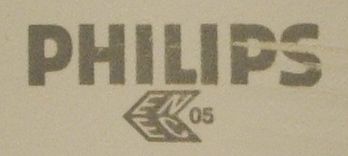
| Manufacturer: | Philips |
| Model: | PL E-T Pro 23W Warm White E27 |
| Application: | General Lighting |
| Wattage: | 23W (24W Measured) |
| Diameter (max): | 60mm |
| Length: | 160mm |
| Tube Length: | 540mm approx (10mm diameter), 3-U style |
| Bulb/Tube material: | Glass. Colour 827 phosphor coating on inner surface |
| Colour Temperature: | 2700K CRI: Ra 82 |
| Peak output wavelength: | N/A |
| Total light output: | 1485Lm (64.6Lm/W) |
| Rated lifetime: | Not known |
| Cap: | E27 |
| Operating voltage: | 230-240V AC 50-60Hz |
| Operating current: | 160mA (pf = 0.59) |
| Warmup/restrike time: | 1 minute/none (Instant Start type ballast) |
| Cost (original): | £7.99 (Late 2003). |
| Place of manufacture: | Poland |
| Date of manufacture: | March 2003 (Date code C3) |
| Lamp Status: | Working |
This is one of my older acquisitions, at least in that it predates the real take-off in my interest in lighting as something beyond a simple passing interest. Originally this lamp was purchased to replace an ancient (if I'd known at the time it was so old, I'd have saved it!) 200W incandescent lamp in an up-lighter in here - which had eventually blown. Even before that, it was ridiculously over-rated for what I needed it to do, this lamp serving the purpose much better - with the added advantage of NOT repeatedly trying to make my bed covers catch fire when I wasn't looking!
The Philips PL range is rather extensive, having both integrated and non-integrated versions of a variety of styles of lamp, in a variety of ratings. A non-integrated version of the PL-C style lamp (which has four straight parallel tubes making up the discharge vessel) is featured on another page on this website. The PL-T style as featured here however, uses three parallel U-shaped tubes to form the discharge vessel. The additional E in the name indicating the presence of the electronic ballast in this lamp.
This is a lamp aimed more at the professional customer than the general retail market, hence the rather utilitarian appearance, and graphically simple packing (alas, due to when I got this lamp, I never saved that - at least not to my knowledge, given my hoarding instinct, it may well turn up somewhere to prove me wrong though!). Also to prove that point, is that the lamp has not (visibly) changed in the three years since it was made, though I would assume that slight refinements have been made to the phosphor formulation and the electronics to improve lumen maintenance and to extend the life expectancy of this lamp. Other than that, it would appear to be a distinct case of "if it ain't broke, don't fix it" approach that's in operation here. Philips have a design that works, and is liked by the trade, so they've got enough sense not to go messing with it.
My only real gripe with this lamp is that is features an instant start ballast - meaning that the lamp lights the moment that power is applied to it. This is done by simply applying a very high voltage across the lamp cathodes, causing the gas filling to be ionised and to start conducting. The unfortunate side effect of this "instant" start, when the electrodes are cold, is that it is very hard on the lamp electrodes, causing a significant amount of material to be effectively "ripped" off the surface (known as sputtering) - mostly ending up attached to the walls of the tube in this area. This is the blackening that you see at the end of most fluorescent tubes as they age. This is something which invariably happens during the life of tubes, but starting in this manner does the most damage. There is a way to reduce the stress placed on the electrodes during in starting - that is "warm starting" the lamp. This is where a current is first passed through the electrodes, causing them to be heated (usually enough to produce a dim orange glow) for half a second or so. When the electrodes are heated in this manner, it causes them to start emitting electrons by thermionic means (go take a look at how a thermionic valve (vacuum tube) works - the principle is the same). This thermionic emission allows the voltage required to strike the lamp to be reduced considerably, and prevents so much material from being sputtered from the electrodes. To be honest, I'm somewhat surprised that a lamp in this price bracket does not make use of a ballast equipped to do this.

Philips PL E-T Pro 23W Warm White E27 Compact Fluorescent Lamp - General overview

Philips PL E-T Pro 23W Warm White E27 Compact Fluorescent Lamp - Detail of lamp cap

Philips PL E-T Pro 23W Warm White E27 Compact Fluorescent Lamp illuminating my workstation from a distance of approximately two metres

Philips PL E-T Pro 23W Warm White E27 Compact Fluorescent Lamp - Overview of lamp while lit

Philips PL E-T Pro 23W Warm White E27 Compact Fluorescent Lamp - Adjacent to a ruler to show length of lamp

Philips PL E-T Pro 23W Warm White E27 Compact Fluorescent Lamp - Output spectra

Philips PL E-T Pro 23W Warm White E27 Compact Fluorescent Lamp - Detail of text printed on base of lamp (1/2)

Philips PL E-T Pro 23W Warm White E27 Compact Fluorescent Lamp - Detail of text printed on base of lamp (2/2)
This lamp added to the Virtual Display Shelf on the 19th February 2006 at 00:17.
References: None.
Acknowledgements: None.
This page was last updated on the 15th of June 2023: Page formatting changes to improve readability on mobile devices and some background code changes to improve search engine behaviour.